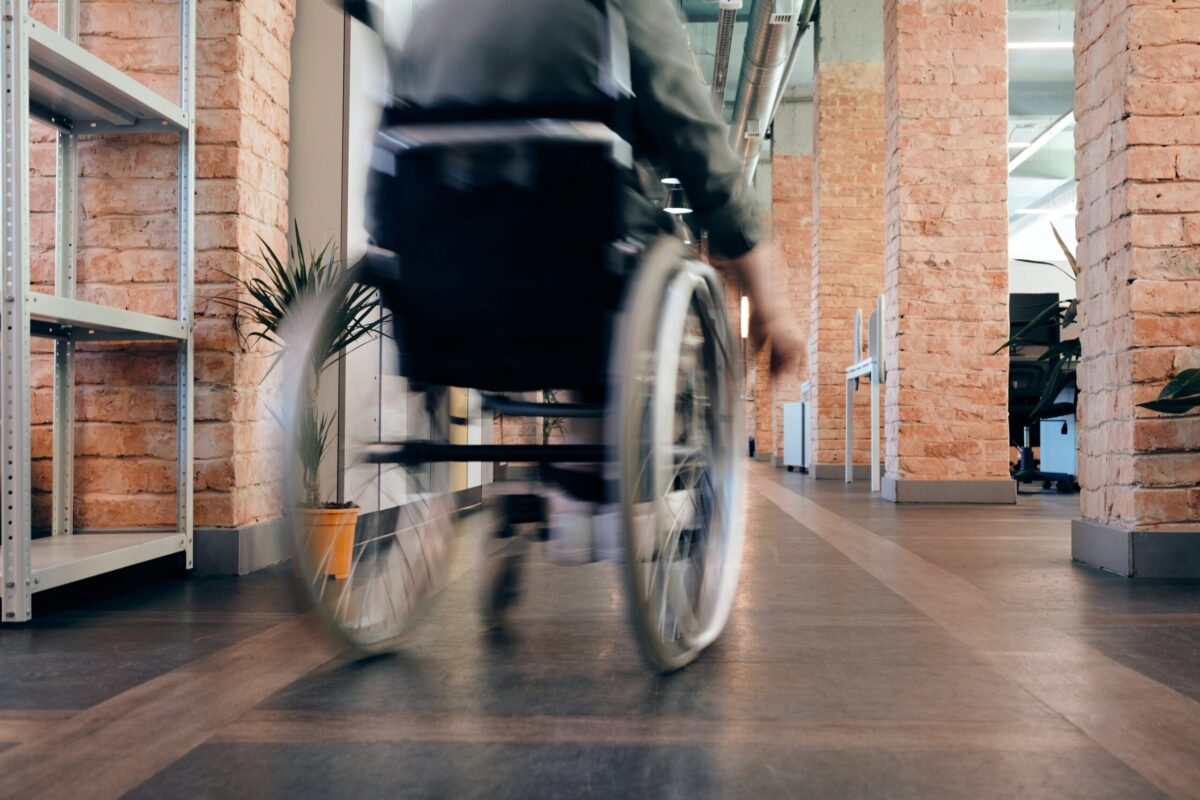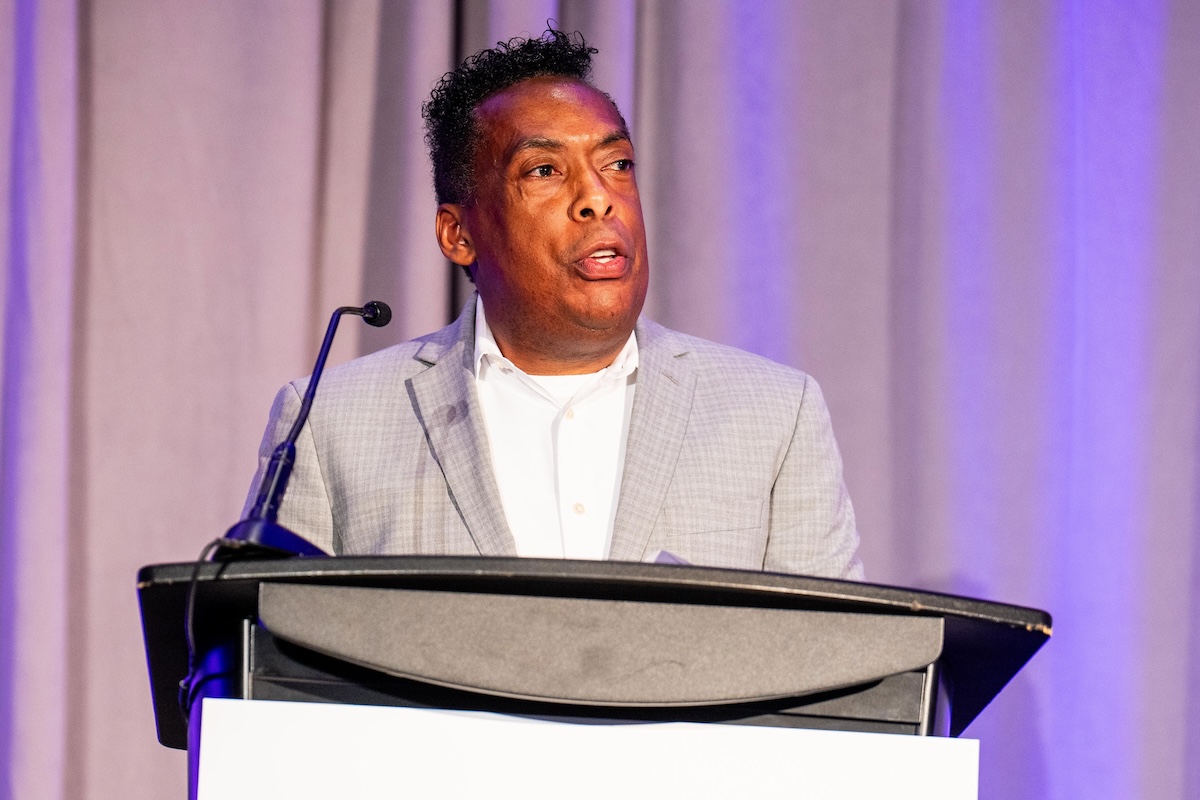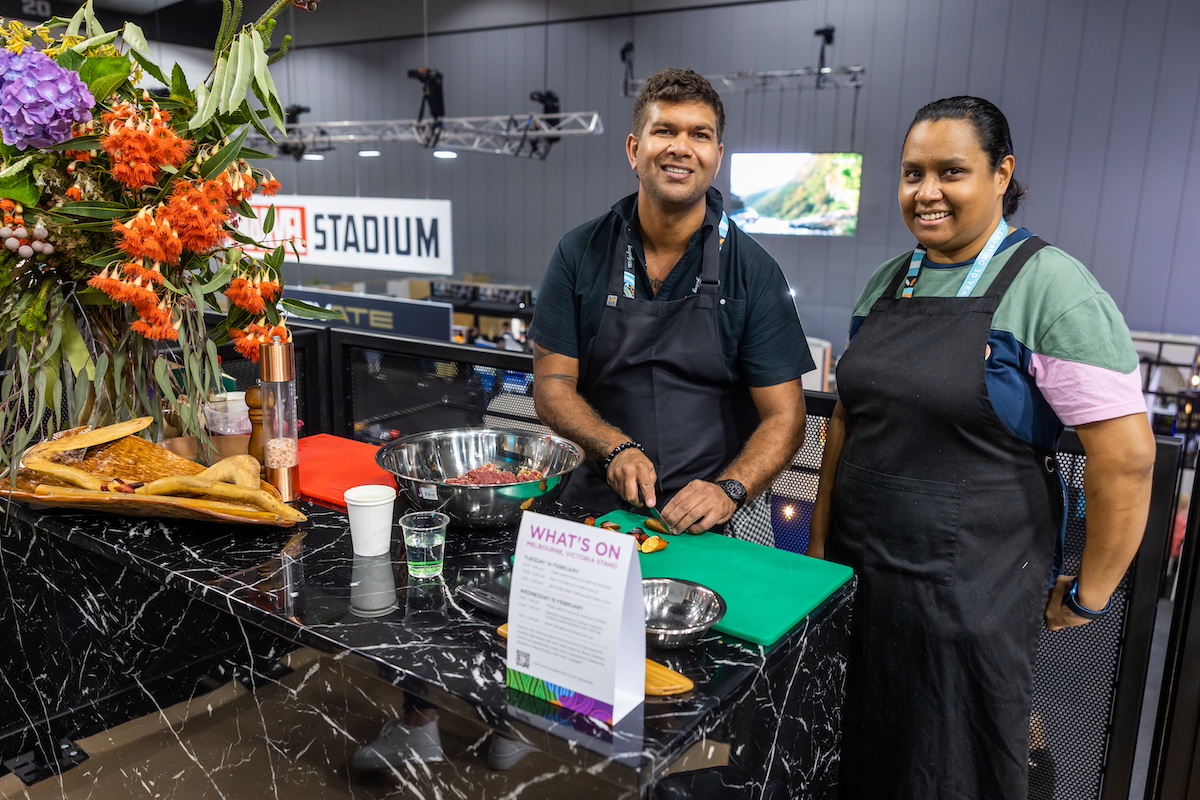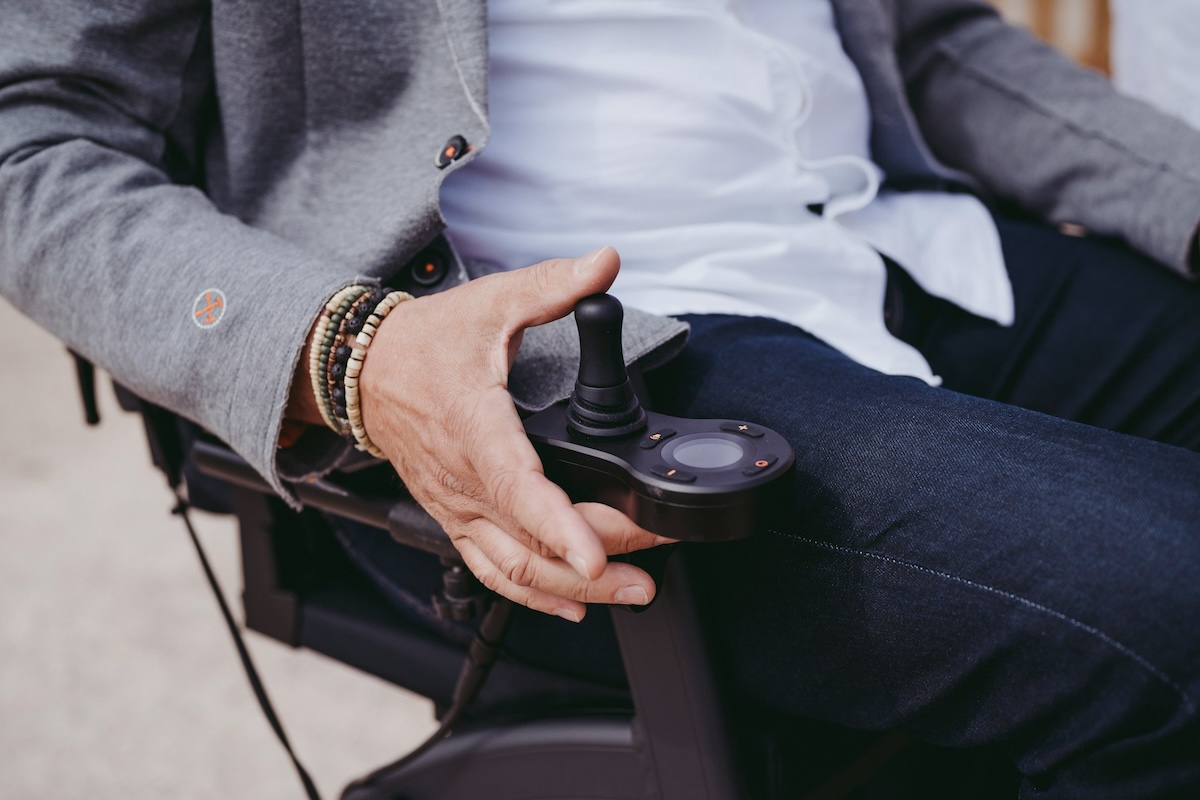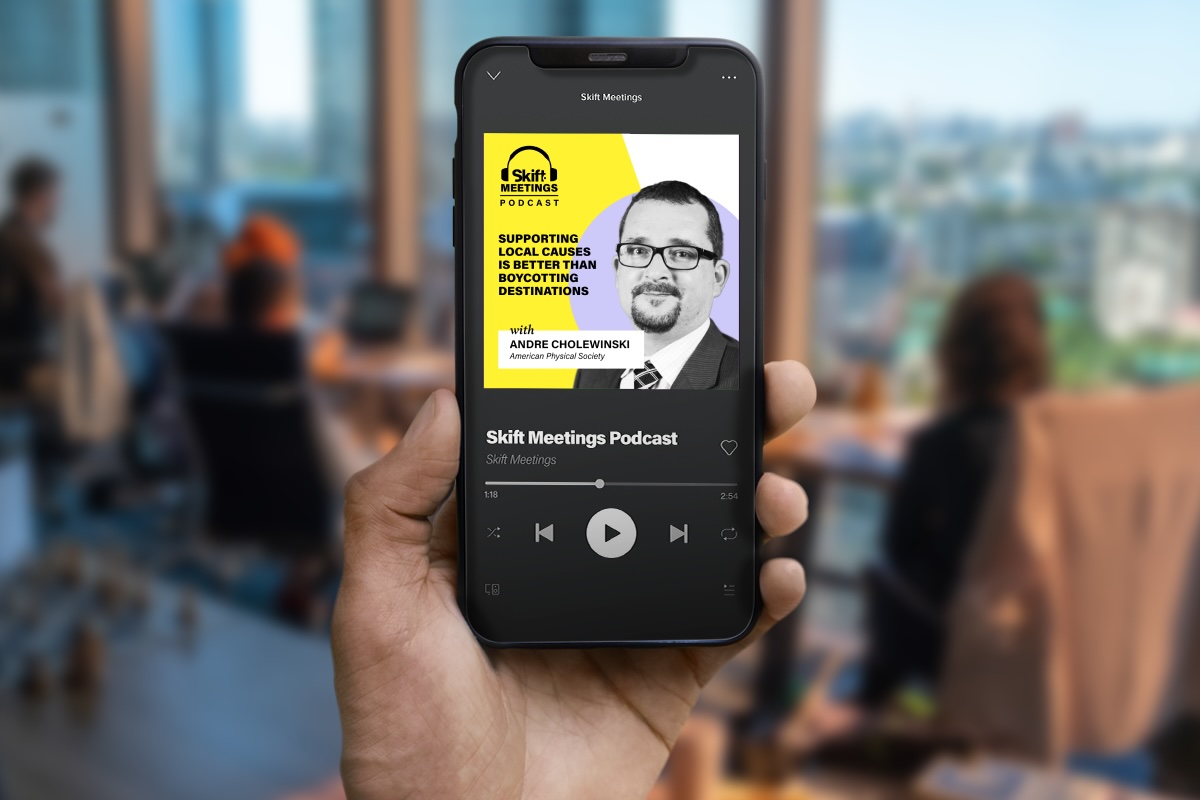Skift Take
After Skift Meetings published an article about a wheelchair venue tour, accessibility advocates strongly objected to disability simulation exercises. Now, we are revisiting the topic to provide a platform for the concerns that were raised.
Meeting professionals hold a set of core beliefs about what makes a successful event. For many, the more experiential an activity is, the better. This is particularly true if it evokes strong emotions to raise awareness around a good cause. Disability simulation exercises put this belief to the test.
Just ahead of the 33-year anniversary of the Americans with Disabilities Act (ADA) in June of this year, Skift Meetings reported on just such a disability simulation exercise that took place at PCMA’s EduCon in Montreal. Led by 25-year wheelchair user and disability advocate Rosemarie Rossetti, the activity prompted participants to tour the event’s venue in a wheelchair. Throughout the tour, Rossetti explained key accessibility concerns for those who use mobility aids. She added tips on how to design more inclusive events for this audience.
The reaction to the Skift Meetings article was swift — but it was not, for the most part, in praise of the advice shared during the tour. Many high-profile accessibility advocates and consultants expressed strong objections to the idea of “trying on” a disability, even if the intention was educational. A LinkedIn post by disability rights activist Emily Ladau received almost 1,100 likes and over 200 shares.
Now in the midst of National Disability Employment Awareness Month (NDEAM), Skift Meetings is revisiting this heated topic to provide a platform for the concerns that were raised.
What Are the Objections?
While Ladau’s post garnered over 100 comments, there were common threads throughout them. The criticism boiled down to five interrelated concerns:
1. The Danger of Treating Disabled Identities as a Game of Pretend
The most prominent complaint — and the most nuanced — was that these types of simulation exercises involve taking on someone else’s identity. “I really can’t help but feel like it comes down to this game of dress up and of trying things on in a way that doesn’t meaningfully connect you to what it is like every day to live my life,” said Ladau in an interview.
In 2014, Ladau penned an op-ed, “I Won’t Pretend That Disability Simulation Works,” that explored this issue in more depth. Disabilities aren’t just physical or mental states of being; they represent communities with their own distinct cultures.
The Blackface Comparison
As part of this conversation around identity, some commenters made the comparison between disability simulation exercises and Blackface. The analogy has been circulating for years among disability groups, and the phenomenon of “simulating” or “mimicking” disabilities is sometimes referred to as “cripping up.”
Some, however, object that the comparison overlooks vast differences in the history and intention behind the two acts. For a nuanced article that covers the thinking behind the comparison along with objections to it, consider reading Please Stop Comparing Disabled Mimicry to Blackface by Dom Evans, an activist who focuses on LGBTQIA+ and disability rights.
Event planner and DEI advocate Zoe Moore, who is a Black service-disabled veteran, echoed the sentiments expressed in the article:
“First, when I hear that, it’s an emotional response. Second, it shows a lack of knowledge about the history of Blackface. Watch Birth of a Nation to see why Blackface was used to depict Black men as apes. It’s such a harmful statement that the comparison is unequivocal. The purpose of this training is so that in the event industry, we do better. Putting on Blackface was to completely mock a whole race of people.”
Though Ladau’s 2014 article made a comparison between Blackface and “cripping up,” she has since come to recognize how problematic it is to equate the two. “We have to be clear that there’s a very different history of harm there,” she said.
A Word of Caution for Planners
For event planners, the lessons here are multifold. Identity politics are an extremely sensitive issue, with deep meaning to those with personal ties to the most affected groups. Any activities that allow participants to temporarily “try on” someone else’s day-to-day experiences should be approached with caution and consultation with the relevant group(s). It’s also vital to be conscientious about the language we use and the comparisons we make — particularly when they carry heavy historical contexts.
Regarding disability simulations, activist Samantha Evans also believes it’s important to inform participants ahead of time about how disability rights groups may perceive these activities. “The disability community is not a monolith. It’s not one big entity, and there are different perspectives,” she said. Nevertheless, she noted that many prominent disability groups have spoken against these types of exercises.
2. The Misleading Impression of Lived Experience
Closely related to concerns around the co-opting of identity is the objection that these exercises can provide a false sense of confidence around understanding accessibility needs.
Jenn Ramirez Robson, vice president of employment services at Northwest Center, cautioned that these brief exercises will never impart a true understanding of what it means to live with a disability. “You can’t imagine other people’s lived experience. Whether you’re trying to build a tool or create an event space for folks, you’re going to miss the nuances,” said Ramirez. She noted that beyond missing some barriers that disabled people face, it’s also possible to put too much emphasis on minor issues that people with long-term disabilities have already adapted to. “You’re going to make assumptions based on what was hard for you in that hour.”
Rosemarie Rossetti acknowledged this concern, stating that the tour was intended as a starting point rather than as comprehensive training.
3. The Implication That Listening Isn’t Enough
Another major repeated concern was the question of why experiential simulations are necessary. What can they teach event planners that they can’t learn from accessibility consultants and a multitude of industry resources on the topic?
“Why do you have to wait until you experience it to realize that there’s something important in what I’m telling you?” asked event planner and accessibility consultant Nell Koneczny.
Rossetti explained her motivations in terms of knowledge retention rather than persuasion. “When you’re teaching someone new skills, you can talk about it, you can read about it, or you can experience it. And when you look at how adults learn, they’re going to learn more by doing,” she said.
Koneczny, on the other hand, believes it’s about privileging first-hand experience over listening to the voices of others. “Instead of trusting your peers and your community members, you are trying to become the expert.”
4. The Potential for Emotional Reactions to Backfire
While the events industry tends to value strong emotional responses to experiential activities, it’s important to consider whether this impact is always beneficial. Multiple commenters voiced the concern that activity participants could come away with feelings of pity and fear for disabled people.
“I understand that these kinds of experiential activities are well-intentioned. But it’s very easy for these kinds of activities to backfire,” cautioned Ladau. “It may open a person’s mind in some capacity, but it also really contributes to that overarching sense of fear and concern that I don’t want disability to happen to me.”
“The purpose was to educate people on how to plan meetings, rather than experience an empathetic view of a person who uses a mobility device,” countered Rossetti. “And we specified that intent orally at the beginning of this presentation.”
PCMA’s Event Leadership Institute, which played a major role in organizing the simulation activity, also surveyed participants by asking them to agree or disagree with the following statement: “This immersion was focused on generating pity for people in wheelchairs.” Twelve out of thirteen participants strongly disagreed, and one somewhat disagreed.
Several interview sources questioned whether there might be unconscious biases that participants weren’t voicing. According to Samantha Evans, multiple studies show that simulation exercises risk doing more harm than good. One study by researcher Dr. Arielle Silverman, for example, found that students asked to perform a task while blindfolded rated the blind as less capable than those who did the same task without a blindfold. On the other hand, when she later designed another study with an emphasis on using assistive devices to aid with task completion, participants left with an improved view of the capabilities of disabled people.
What does this mean for event planners? An emphasis on the tools (and design features) that can help may be more important than trying to simulate the disability itself.
5. The Risk of Taking Resources Away From Disabled People
While many of these concerns fall in the realm of sociological implications, Koneczny also raised an undeniably practical concern. If mobility devices are used for a simulation exercise, it risks diverting those resources away from a disabled person — particularly when they are rented from a company that has a limited supply, as they were for the PCMA activity. What if a wheelchair user needs to rent a wheelchair at the last minute, but none is left at the rental provider?
Koneczny said that this is an issue she has to consider every time she rents wheelchairs for events, just in case any attendees might need one. “As an accessibility professional, my responsibility is to ensure that the amount of rented product is actually likely to be utilized and not removing inventory from people who need it,” she explained. This can even be a concern for other finite resources like sign-language interpreters.
PCMA and the Event Leadership Institute reported that their supplier did not run out of rentable wheelchairs as a result of their tour. However, it is important to be mindful of this risk whenever planning activities of this kind.
Accessibility Solutions
While there is some disagreement about the best way to teach accessibility best practices, interview source after interview source emphasized the importance of seeking advice from accessibility consultants.
They also pointed to resources like the U.S. Access Board’s animation videos, which help to visualize accessibility needs, and the ISO’s thorough accessibility standard.
Samantha Evans also emphasized the importance of factoring in accessibility at the RFP stage. “For site selection, the challenges start with your RFPs and what questions to ask the conference services managers,” said Evans.
John Sage, CEO and founder of Sage Inclusion, seconded this advice. He added that it’s crucial not to treat accessibility as an afterthought. “Accessibility is normally handled during registration by asking, ‘Tell us what accessibility needs you have,’” he explained. According to Sage, this approach presents two problems: “First, it puts the responsibility on me to communicate my needs. Second, I can’t even communicate my needs if I don’t know what the accessibility landscape looks like.” There are so many details that go into accessible design that an individual attendee cannot possibly list them all — and by the registration stage it would be too late to implement most of them anyway.
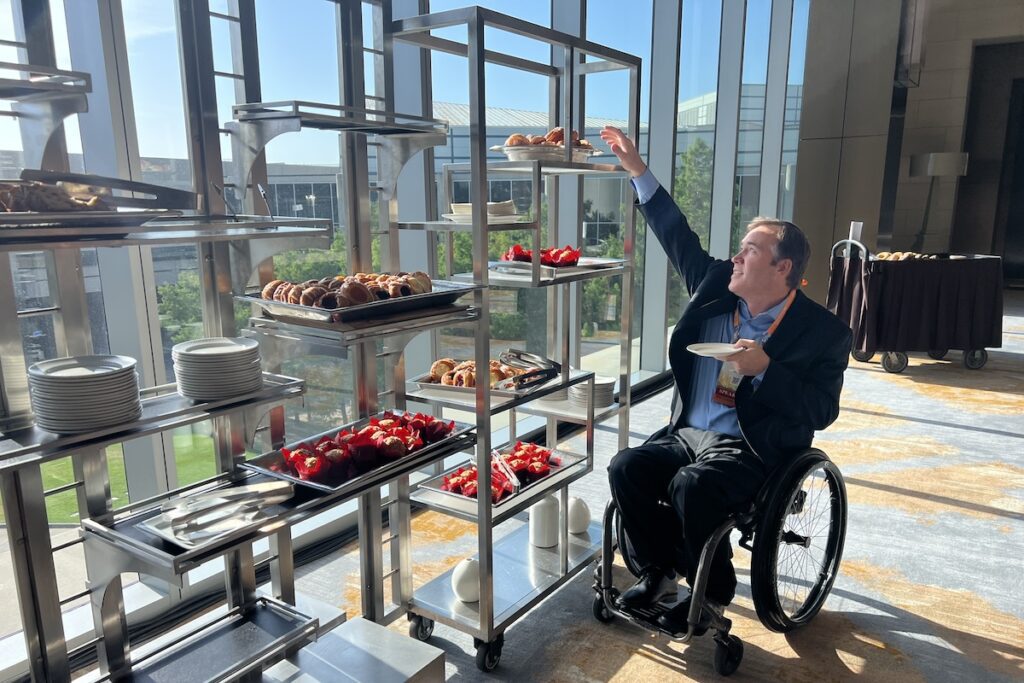
It’s the event organizer’s responsibility to research these needs ahead of time. This should ideally be through a consultation process that includes accessibility experts and those in the disability community. Then, it’s incumbent on the event organizer to communicate what those arrangements are.
Alternative Experiential Approaches to Disability Simulations
Can a simulation exercise help in this effort? The potential educational benefits may be up for debate. However, a full understanding requires far too much expertise to pick up in an hour-long tour. In fact, many experts will say they still learn new information every day.
Can the visceral elements of experiential learning ever provide a benefit? Joshua Klipp, founder and principal of Made Welcome and a PCMA educator, thinks it’s vital to shift the emphasis away from the disabilities themselves to the environment they’re up against. He once divided participants into groups of three and asked them to choose who would be carried across the room. None of them wanted to be handled in that way. “Then I put up a picture of a person in a wheelchair sitting at the bottom of a set of stairs. Could you just carry them up? Well, how did that feel when you thought somebody was going to carry you?”
Klipp cautioned that simulation exercises are tricky: “It can give this impression of almost disempowerment — that a disability is a disempowerment — as opposed to the way that we have set up our world is the disempowerment.”
Ultimately, most agreed that sharing experiences with disabled people and forming relationships with them may be the most powerful experiential lesson.
“I’m proud to have a disability. I’m proud to have this identity. And I often say that so much of what disables me is not my own existence, but rather the fact that people are not willing to be welcoming to my existence.”
Emily Ladau
Is the world really built for non-disabled people? Imagine an event where all of the communication is in sign language and braille. Imagine a bridge with just two thin rails spaced just right for wheelchair tires and nothing but cushioning underneath.
Now imagine an event where a speaker who uses a wheelchair has to drag himself up the stage steps because there’s no ramp, and he doesn’t want to be carried — one interview source witnessed this at a recent conference. It’s time to ensure that event spaces are welcoming for everyone.
Photo credit: Marcus Aurelius / Pexels
